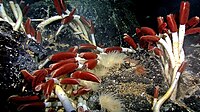
Uncovering Active Bacterial Symbionts in Three Species of Pollen-feeding Beetles (Nitidulidae: Meligethinae).
Sign Up to like & getrecommendations! Published in 2022 at "Microbial ecology"
DOI: 10.1007/s00248-022-01964-3
Abstract: Microbial symbionts enable many phytophagous insects to specialize on plant-based diets through a range of metabolic services. Pollen comprises one-plant tissue consumed by such herbivores. While rich in lipids and proteins, its nutrient content is… read more here.
Keywords: bacterial symbionts; uncovering active; symbionts three; active bacterial ... See more keywords

Spatiotemporal patterns and environmental drivers of total and active bacterial abundances in Lake Taihu, China
Sign Up to like & getrecommendations! Published in 2020 at "Ecological Indicators"
DOI: 10.1016/j.ecolind.2020.106335
Abstract: Abstract Bacteria are a key component in lake ecosystems, playing a crucial role in driving biogeochemical and energy fluxes. In lake biomonitoring, false alarms have often been triggered due to the presence of abundant dead… read more here.
Keywords: variation; environmental drivers; lake taihu; active bacterial ... See more keywords

P634 Surveillance for disseminated gonococcal infections, active bacterial core surveillance (ABCs) – united states, 2015–2018
Sign Up to like & getrecommendations! Published in 2019 at "Sexually Transmitted Infections"
DOI: 10.1136/sextrans-2019-sti.702
Abstract: Background Disseminated gonococcal infections (DGI) are uncommon; occurring in an estimated 0.5–3% of Neisseria gonorrhoeae (GC) cases. DGI surveillance is limited and case reports are often analyzed retrospectively or in case clusters. We describe the… read more here.
Keywords: gonococcal infections; surveillance; case; dgi ... See more keywords

Metatranscriptomics Reveals the Active Bacterial and Eukaryotic Fibrolytic Communities in the Rumen of Dairy Cow Fed a Mixed Diet
Sign Up to like & getrecommendations! Published in 2017 at "Frontiers in Microbiology"
DOI: 10.3389/fmicb.2017.00067
Abstract: Ruminants have a unique ability to derive energy from the degradation of plant polysaccharides through the activity of the rumen microbiota. Although this process is well studied in vitro, knowledge gaps remain regarding the relative… read more here.
Keywords: cow; bacterial eukaryotic; dairy cow; metatranscriptomics reveals ... See more keywords